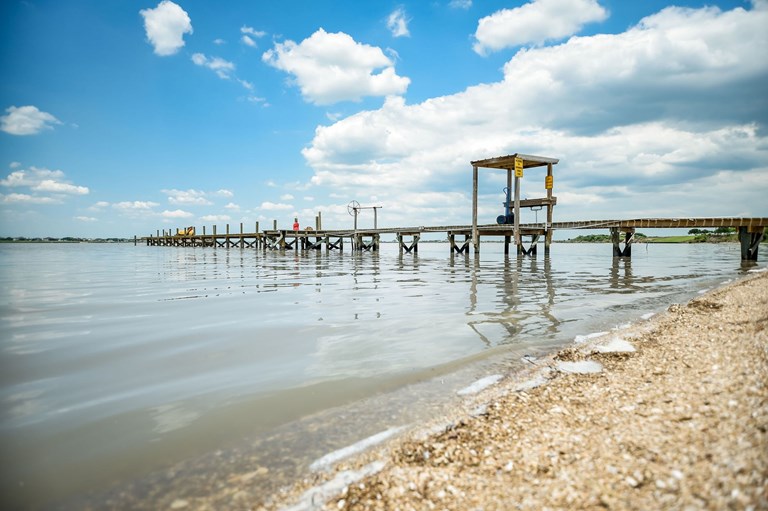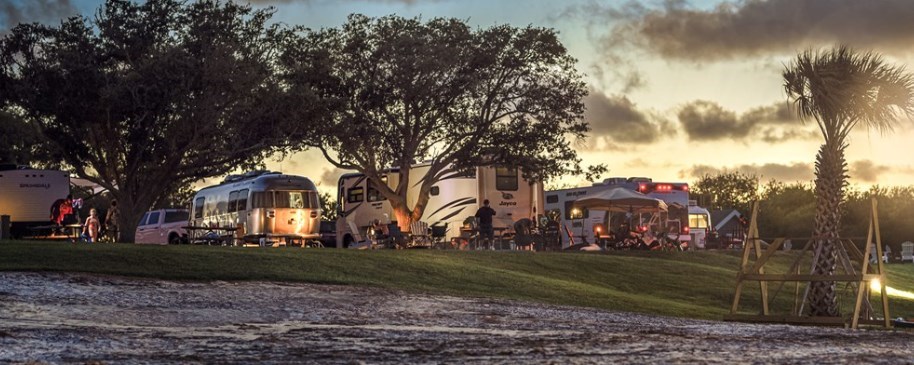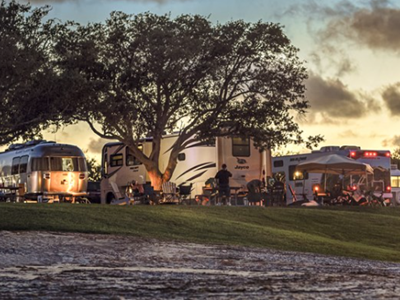Your cart is empty!
Make checkout easy by booking all your reservations at once. Add your sites from different campgrounds into your shopping cart* and then choose checkout.



1. If you don’t know what your RV weighs, it’s probably overloaded.
2. Two carpet samples, one placed at the base and another at the top of the entry steps, will help keep dirt and moisture out of the interior.
3. Write down your vehicle’s exact exterior height (remember to add the A/C) and GVWR and keep it inside your cockpit so you never exceed your weight or risk a nasty incident going under an overpass.
4. Never drive more than 500 miles per day. Actually, 400 is pushing it.
5. Backup monitors are wonderful, but expensive. If you’re in the market for one, make sure the camera works in the dark, since a majority of your back-ins will probably occur after the sun goes down.
6. When tackling tough ascents, go down the hill in the same gear you went up in.
7. We don’t really have to remind you to regularly check your LP gas, smoke, and carbon monoxide detectors, do we?
8. Ah, duct tape.
9. Teach your co-pilot to drive and let him or her take the wheel often. Sharing the driving duties cuts down on driver fatigue while reinforcing the notion that RVing is for both of you. Another perk? If the main driver should ever become sick or hurt, you won’t be stranded.
10. Surge protectors offer cheap insurance against power spikes for all your pricey, onboard equipment.
11. Don’t risk traveling in an overloaded vehicle. Not only does extra weight accelerate wear and tear on your RV, but if you’re involved in an accident, expect a weigh-in to be performed. An overweight vehicle may void any insurance claims and might find you liable. Don’t take chances with this.
12. Visit every national park.
13. During an argument, eliminate the words “never” and “always” from your vocabulary. A happy co-pilot is the key to a pleasant journey.
14. If you feel cramped in a 40-foot Prevost bus, RVing is not for you
15. Put a roll of quarters in your shower kit in case you’re faced with a bathroom that insists on pay showers. Believe me, it’s hard to get change for a twenty-dollar bill wearing only a robe and slippers.
16. On your way out, be sure to tell the campground owner how much you disliked paying for showers.
17. Conserving resources is a good habit. Don’t let the water just run when washing hands, dishes, or brushing your teeth.
18. If you don’t like where you are, go someplace else.
19. Compile and laminate two basic lists: one for setting up your campsite, the other for breaking camp. That way, you’ll never drive off with your antennae up again.
20. Carry a box of disposable rubber gloves for use during sewer hookups and the dump station.
21. Before leaving the dealership with your new RV, arrange for a walk-thru with your salesperson to make sure every appliance, utility, and function onboard is in top working condition.
22. Your cockpit can’t be too comfortable.
23. A good set of mud flaps should help keep debris off your dinghy vehicle. There are also a number of protective covers and shields available to safeguard the towed vehicle as well.
24. Your kids and grandkids worry about you. Leave them the names and numbers of the places you’ll be staying during your travels.
25. A partially folded paper plate makes for a usable funnel in a pinch.
26. If an extension cord is needed for your electric hookups (really any type of hookup for that matter), use the shortest length available. The longer the distance, the greater the voltage drop will be.
27. Visit Maine.
28. Trash onboard your rig is always a major hassle. Eliminate unnecessary garbage by taking food such as cereals, meat, and coffee out of their overblown packages and into smaller ones. Contribute old reading materials to the campground’s rec. room and re-use or recycle old shopping bags.
29. I see no reason to stand on top of your RV unless there’s a bucket of soapy water and a brush with you.
30. Furnace 101. Check the outside vent periodically for soot, a sure sign of faulty operation. Clean and vacuum the unit as necessary. Check hoses for kinks; replace as needed. Have the system inspected once a year by a professional.
31. Wash your vehicle in the shade. The sun quickens drying time of cleaning agents and makes waxing more difficult.
32. Ah, sway bars.
33. Use an onboard timer for lights to thwart would-be thieves, just as you might for your home while you’re away.
34. Avoid nasty spills by equipping the entryway with handrails.
35. Carrying two 25-foot hoses is better than one 50-foot hose.
36. When making campground reservations, take a few extra minutes to describe exactly the kind of site you want. If you prefer to be close to the bathroom or swimming pool, need fewer trees due an extra large vehicle, or simply want the prettiest site in the place, be sure to tell them.
37. A GPS is nice, but nothing beats a compass to keep me from driving around in circles.
38. Change your windshield wipers annually.
39. CB chatter can be crude and distracting. However, it can also be a valuable resource for upcoming traffic, weather, and area recommendations. It’s also a nice companion on a long drive.
40. Fruit and vegetables from a roadside stand always taste better.
41. Believe me; no one over the age of 13 wants to sleep in the cab-over area.
42. Make sure your RV insurance covers you during any trips abroad.
43. Good drivers should carry a higher deductible on their insurance.
44. Bring the grandkids.
45. Want better-tasting hamburgers, steaks, and poultry? Let cooked meats sit for several minutes before serving. Cooking at high heat forces juices inward, leaving your food less juicy. Waiting a few minutes prior to eating makes a big difference.
46. It’s not camping unless there’s S’mores.
47. Of course you know that your RV must be level for the refrigerator to work properly.
48. Create an emergency kit and put it in an outside storage compartment. It should include first aid supplies, a pencil and paper, flashlight, and disposable camera for capturing the scene of an accident. Compile a list of names (doctor, insurance agent, lawyer) and any medications you’re currently taking. Then hope there’s never a need to open it.
49. Once you use an electronically-deployed awning, you’ll never go back.
50. Don’t mess around with your tires. Inspect them often and replace at the first signs of cracking or worn tread. It’s also better to buy them in pairs. Check tire pressure before any big trip.
That doesn't mean this area has to always be empty. When you start reviewing camping options, your history will display here to help compare sites and find the best stay. You will be able to share your stay information with friends or family and save it for a later time if you have a KOA Account.
Make checkout easy by booking all your reservations at once. Add your sites from different campgrounds into your shopping cart* and then choose checkout.